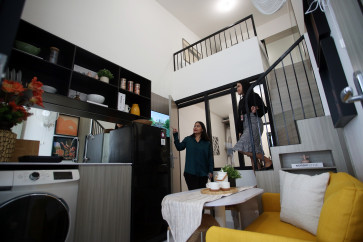Popular Reads
Top Results
Can't find what you're looking for?
View all search resultsPopular Reads
Top Results
Can't find what you're looking for?
View all search results119 villages in Jember left in the dark
The dusk was due to set on a Sunday evening as Soleha, 34, a resident of Karangkatak village in Jember, East Java, prepared to take her children to another village in the Jumerto subdistrict - about 1 kilometer away - for a Koran recital
Change text size
Gift Premium Articles
to Anyone

The dusk was due to set on a Sunday evening as Soleha, 34, a resident of Karangkatak village in Jember, East Java, prepared to take her children to another village in the Jumerto subdistrict - about 1 kilometer away - for a Koran recital.
She went to the backyard and emerged five minutes later with three fire torches. She gave two to her children Khotim, 10, and Faiz, 9.
"Passages here are dark at night, so we have to bring torches or flashlight," Soleha said.
She led her children, walking along dikes in paddy fields, the only connection from their village to the outside world.
Soleha promptly went back home after her children joined their friends.
"I'll be back to pick them up after evening prayer," she said.
She said her village was usually only illuminated by electricity for half the day.
People chose to stay at home after dusk, she said. When they went to sleep and turned off their kerosene-powered lamps, the village was gone with the night.
"Passages in our village become bright and clear only when there is a wedding," she said, looking at the sky.
Karangkatak village is 6 kilometers from the Jember regency administration. But that proximity does not make it easy to have electricity.
Another Karangkatak villager, 30-year-old Syaiful, said the village was remote from other villages, which discouraged state power firm PT Perusahaan Listrik Negara (PLN) from providing them with electricity.
"We have even repeatedly applied for road repairs *to make the village more accessible*, but there was no response from the subdistrict office."
The Karangkatak villagers' experiences are only a glimpse of a bigger picture.
According to the head of electricity and power division at the Jember Trade and Industry Agency, Harimurti, at least 119 of 201 villages in Jember remain unpowered.
"Each village is occupied by 100 to 200 households. This means around 17,850 households in Jember do not have electricity *in their homes*."
He explained mountainous topography and limited road access made it difficult for PLN to build electricity networks in those areas.
But, he said, the administration had an electricity procurement program in villages.
"*The administration* allocated Rp 1.5 billion *US$145,500* for 2009," Harimurti said, in reference to the budget that would finance illumination projects in 59 villages, out of the 119 villages without electricity.
For areas that are hard to reach by PLN, he said, the administration would help through the establishment of power generators with alternative energy sources, including solar power.
According to the agency's record, there are 150 solar-powered electric generators (PLTS) in five villages in the Mulyorejo subdistrict to help mitigate power shortages.
"We aim to build 4,000 PLTS," Harimurti said.
However, he admitted establishing a solar-powered electric generator was not financially efficient, citing the price of the equipment required and the power it produced.
One solar-powered electric generator costs Rp 7.5 million and produces only 60 watts.
"Actually, there's another potential alternative that the Jember regency administration plans to use - micro-hydro power," he said.
An agricultural engineering professor at the Jember Polytechnic, Michael Joko Wibowo, said micro-hydro power plants generated power with the same principle as a hydroelectric power plant by using the potential energy of waterfall, but at a much smaller scale.
He said the energy yielded from a micro-hydro power plant was not as huge as that produced by a hydroelectric power plant for an industry.
However, waterfall was not required for a micro-hydro power plant to generate power as long as there was water to move the turbines.
A micro-hydro power plant also required less equipment and space.
"So it won't damage the environment," Joko said, adding there are at least 10 potential locations in Jember for a micro-hydro power plant.
However, only one micro-hydro power plant has been built so far, namely in Mojang village in Jumerto, Patrang, in 2001 by five staff of the polytechnic with "relatively small" investment.









